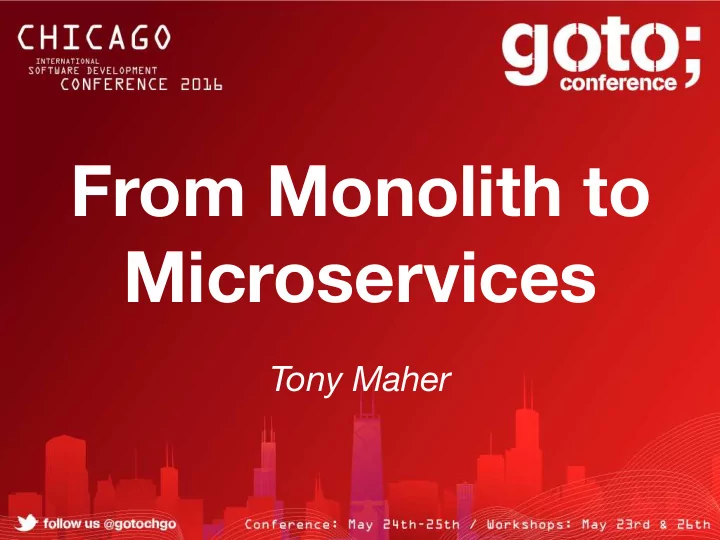

From Monolith to Microservices Tony Maher
Dose Media • www.dose.com • www.omgfacts.com • Tony Maher, Team Lead • tony@dose.com, @tonymaher5
Dose Media • Large scale websites - 55 million monthly uniques. • Uptime is paramount. • Small, autonomous, and flexible teams.
Outline • Dose Architecture, 2012-2014 • Results of this architecture • The start of Microservices and steps we started taking • Initial Results • Introduction of Docker • Current Status • Next Steps
Dose Legacy Architecture
Dose Legacy Architecture • ~3 million lines of code • 415 commits to production in Q1 2013, most of which were bug fixes or red alert bandaids.
Dose Legacy Architecture • Response Time: ? • Downtime: ? • Horrible/missing monitoring, logging, documentation
Symptoms
Symptoms
Symptoms
Symptoms • Frequent crashes. • Problem in one area ballooned to problems across entire network. • HUGE resource costs for relatively simple functionality. • Extremely long debug times.
Dose Legacy Architecture • Response Time: ? • Downtime: ? • We know they were reeeeaaaally bad. • Best guess would be around 1-2 seconds server response time, <99.0% uptime.
The Start of Microservices • Full team buy-in… No edicts from the mountaintop. • Multiple microservice related book clubs. • Regular architecture planning meetings.
The Start of Microservices • The general concept: It’s simply good OO class design, abstracted to services and applications. • SOLID Design Principles… SRP
The Start of Microservices • Just little things at first… • Keep modules small and isolated. • No God Classes. • USE INTERFACES. • Split distinct functionality into separate codebase, with its own web cluster, database, cache, everything.
The Start of Microservices • Resource APIs - Data based microservices which just expose related resources/entities. • Service APIs - Behavior based microservices which communicate with Resource APIs. • Client Applications - Web and mobile apps which only communicate with Service APIs.
The Start of Microservices
The Start of Microservices • When we wanted to split a service, but too much of its functionality was still tied directly to the functioning monolith… • We created what we call a “hydra” - shared resources (usually the monolithic database) used by separate services.
The Start of Microservices
The Start of Microservices • At this point (late 2014 - early 2015), we’ve got a couple Microservices, a couple Hydras, and the legacy monolith. • Already we see vast improvements though.
Initial Results • Average server response time: 800ms • Uptime: 99.96% • Still not great, but at least we’re heading in the right direction.
State of Devops • Local development was done in a vagrant box, which may or may not have had the same versions as qa or prod, build or batch nodes. • Updates were run on a long running “build” node with a potentially very different architecture than other environments.
State of Devops • Toss it over the wall attitude toward devops and deployments… “It works locally so must be a devops problem”
State of Devops • So we identified our needs: • Consistency between environments. • Transparency on project requirements and dependencies. • Flexibility to change as we experiment and learn more about the process and how it works for us.
Introduction of Docker • We started using docker-compose , as well as semi-regularly updated docker base images, to ensure consistent architectures across environments. • Moved configuration and deployment closer to development. • Put everything you need to run an environment in the codebase.
Introduction of Docker • Every service has its own docker compose file in its repository. • Versions are imaged by git hash, so docker helps us ensure we’re testing exactly what’s going into production. • Developers are intimately familiar with dependencies and deployment processes.
Current Status • At this point, we’ve… • Created a few independent microservices. • Shunted some of our bulkier legacy functionality into hydras. • Killed a lot of old code. • Started using a docker based deployment pipeline to decrease the differences between environments.
Current Status • From Jan 1, 2016 to now: • Our largest microservice has only a couple hundred lines of custom code. • Websites’ Uptime: 100% • Websites’ Average Server Response Time: 119ms
Next Steps • All new and distinct functionality goes into its own microservice, deployed to its own cluster. • Only communicate with other services over API requests. • NO BACKDOORS. • Use 3rd party resources whenever possible. • Don’t reinvent the wheel.
Next Steps • Continue to decouple the hydras/monoliths. • Convert shared resources into Resource APIs. • Kill legacy code. • Create microservices (or hopefully use 3rd party resources) to help orchestration between microservices.
Key Takeaways • Don’t fall prey to analysis paralysis… take little steps. • Use shunts to ease transitions (but put deadlines on their lifetime!). • Delete code wherever possible. • Treat internal services just like you would 3rd party services.
Key Takeaways • Limit (hopefully to 1 service) the number of integration points to shared systems, especially databases. • Version APIs to further decouple services and prevent changes in one service from affecting another. • Keep micro services so small that it’s easier to rewrite than to refactor.
Questions and Contact • Feel free to reach out… • tony@dose.com, @tonymaher5
Recommend
More recommend